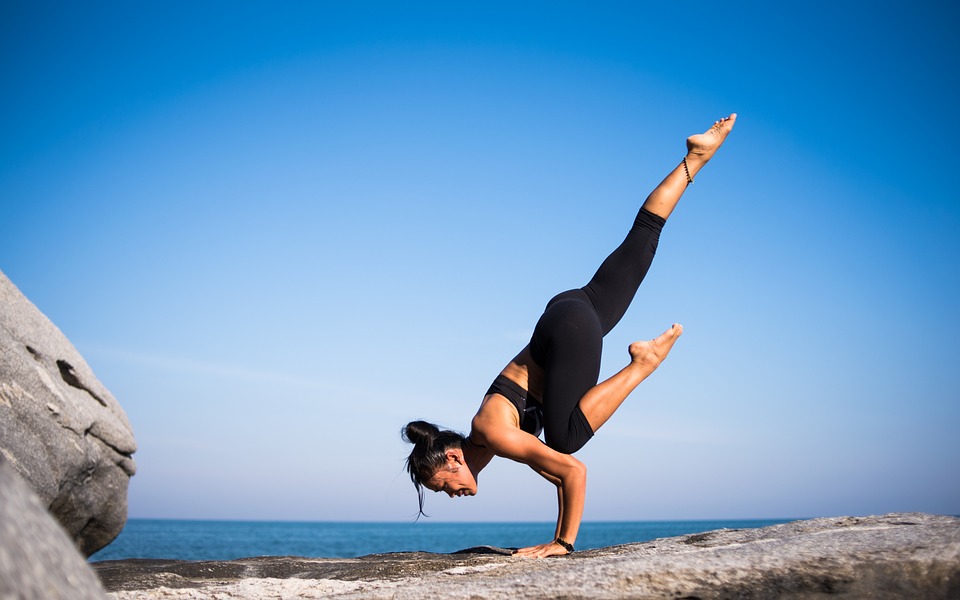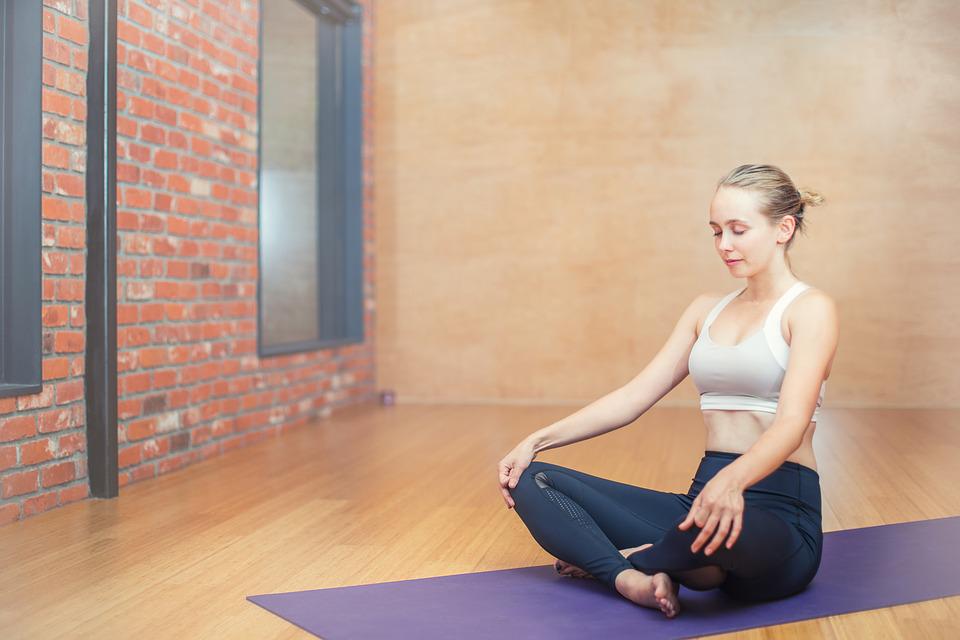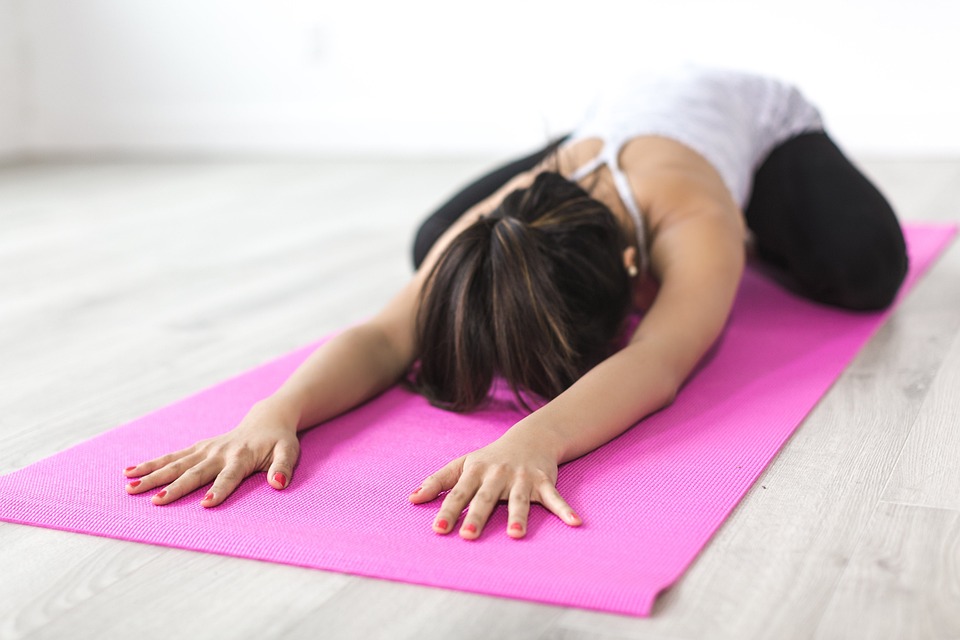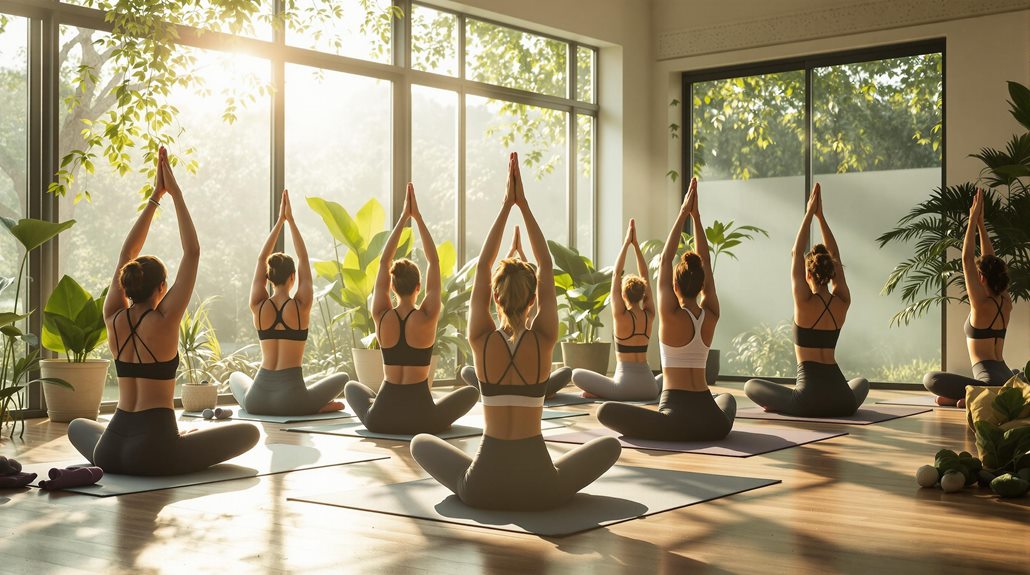
Ready to zap stress and find your zen? Try yoga routines like Child’s Pose or Legs Up the Wall. They’re like a warm hug for your mind! For some deep breathing magic, Alternate Nostril Breathing will have you calmer than a cat napping in the sun. And if you’re up for a snooze fest, Yoga Nidra’s relaxation power is off the charts. Spice things up with Ujjayi Breath—think Darth Vader but Zen. Laugh it off with quick poses during work breaks; even a stressed-out sloth would approve. So, why not embrace these tips for a clearer mind and relaxed body?
Benefits of Calming Yoga
Engaging in calming yoga can transform your mental and physical state by reducing stress and promoting relaxation. Think of it as hitting the “chill” button on life’s remote control.
Restorative Yoga and Yin Yoga are like the VIP passes to your body and mind’s relaxation concert. They invite you to hold poses longer, activating your parasympathetic nervous system—fancy talk for dialing down stress and tuning up relaxation.
Practicing calming yoga helps to improve flexibility and prevent muscle strains, much like the benefits of yoga practices in their entirety. This activation helps lower cortisol levels, the villain behind anxiety and health issues. What’s the payoff? You become a more focused, zen-like version of yourself.
Breathing techniques are your secret weapons here. With methods like Ujjayi and Nadi Shodhana, you’ll be a breath-regulating, anxiety-busting superhero in no time.
Feel the mental clarity wash over you faster than popcorn disappears at a movie night. Even a quick Child’s Pose or Legs-Up-the-Wall can turn your frazzled mind into a serene oasis.
And let’s not forget sleep—our trusty sidekick. Calming yoga can help you catch Zzz’s more effectively by clearing out the mental clutter.
Bottom line? Building a calming yoga practice helps you serve others with renewed vigor and focus. Try it, and watch your life transform.
Essential Relaxation Techniques
Relax and recharge with essential relaxation techniques that enhance your yoga practice. Envision this: you’re diving into yoga, ready to serve yourself and others. So, don’t skip these calming strategies.
Ujjayi Breath? It’s your secret weapon. It’s like your own mini heater, warming you from the inside and helping calm the mind. Just as Pilates promotes core strength and relaxation, Ujjayi Breath centers your mind and body for better balance.
Then, there’s Yoga Nidra, the blissful shortcut to relaxation; it’s like getting the perks of four hours of sleep without, you know, actually sleeping. Amazing, right?
Now, imagine sinking into Child’s Pose or sprawling out in Corpse Pose. These aren’t just poses—they’re mini retreats, whispering stress relief when the world feels chaotic.
Next up, Progressive Muscle Relaxation. Sounds fancy but it’s simple. You tense, then relax. Easy. It’s like routinely letting go of little stress nuggets in your body.
Don’t forget mindfulness techniques like the 5-4-3-2-1 exercise. It’s grounding, with a touch of magic realism.
Poses for Stress Relief
When stress feels like it’s wrapping around you, there’s a powerful yet simple antidote: yoga poses specifically aimed at stress relief.
Picture yourself in Child’s Pose. It’s not just about curling into a ball—it’s about deep breathing and letting go of all that tension lurking around your sacrum. Take ten deep breaths, and feel the stress melt away.
Child’s Pose, mentioned as a key yoga pose for relief, is also ideal for spinal lengthening and muscle relaxation. But wait, there’s more—Forward Bend isn’t just bending over and pretending to touch your toes. This pose boosts blood flow to your head, flipping gravity’s hold on your spine. Suddenly, stress and fatigue become yesterday’s news.
If your legs feel like they’ve run a marathon (while you haven’t), try Legs Up the Wall. This relaxes the lower body and calms the nervous system. Just make sure the wall is sturdy—no holes allowed!
Transition into Butterfly Pose because who doesn’t want to mimic a beautiful butterfly? With deep breathing, your inner thighs and pelvic area relax, promoting stress relief.
Now, for full-body relaxation, there’s Corpse Pose. Yes, you heard right—act like you’re pretending to nap at work. Inner peace, ahoy!
Simpler said than done? Perhaps. Effective? Absolutely!
Breathing for Relaxation
After exploring yoga poses that ease stress, it’s time to focus on the breath—an often underrated yet powerful tool for relaxation. Practicing yoga isn’t complete without embracing breathing techniques that help reduce anxiety and stress. I mean, who knew simply inhaling and exhaling could be a game changer?
Let’s jump in. Ever heard of Ujjayi Breath? It’s like your mind’s personal fireplace, creating internal heat and calm to melt stress away. If your anxious side feels like it’s hosting a party, Alternate Nostril Breathing, or Nadi Shodhana, will balance your energies, leaving anxiety no room to groove.
Craving a mental spring clean? Kapalabhati, with its fast exhalations, can purify your body and energize your mind—talk about a wake-up call!
For those needing to feel like they’re not in a whirlwind, Sama Vritti, or equal breathing, matches your inhalations and exhalations to enhance focus and achieve relaxation.
Pair these techniques with mindfulness. The 5-4-3-2-1 grounding trick engages your senses and, believe it or not, ends with deep breaths.
Yoga for Mental Wellness

Yoga isn’t just a physical exercise—it’s a holistic practice that greatly enhances mental wellness. Imagine chilling out, like your brain’s on vacation, with yoga’s magic touch. By activating the parasympathetic nervous system, yoga helps reduce stress and anxiety through relaxation techniques. You might start a yoga session tense like a coiled spring, but with breath control and mindfulness, like Ujjayi and Nadi Shodhana breathing, kiss those negative thoughts goodbye.
Restorative Yoga, a star in mental wellness, lets you sink into deep relaxation by holding poses longer, providing mental clarity and emotional stability. Picture it as your inner peace spa day without the fancy towels.
Plus, regular practice boosts serotonin—a natural mood enhancer. Suddenly, the grumpy mornings feel less grumpy; you’re more like the “morning person” you swore you’d never be.
Feeling frazzled? Yoga can improve sleep quality by lowering cortisol levels just when your pillow starts winning the battle. It wraps your mind in a blanket of calm and relaxation.
Creating a Mindful Routine
Creating a mindful yoga routine is like training a puppy—consistency is key, and a few treats (or deep breaths) can go a long way!
Start with 5-10 minutes of meditation to set the mood, then blend in some gentle yoga poses and effective breathing techniques like Ujjayi Breath.
Sure, your mind might wander and your cat might interrupt with their own version of “cat pose,” but practicing 3-5 times a week builds habits that stick, leaving you feeling calm and centered.
Building Consistent Habits
Establish a mindful yoga routine by committing to practice consistently 3-5 times a week. Think of it as your gift to the world—because a calm mind inspires a calming effect on everyone around you.
Start with 5-10 minutes of meditation. It’s like telling your mind, “Hey, let’s chill.” Adding breathing techniques helps you connect deeply with your body, while your stress levels melt like ice cream on a sunny day.
Balance your yoga routine with a mix of active poses and restorative poses. You know, like Savasana, which is basically yoga’s way of letting you nap while pretending to work out. Deep relaxation isn’t just for spa days—it’s your ticket to mental clarity and mindfulness.
Remember, your yoga practice is personal. Tailor it to fit your own quirks and preferences. Aim for enjoyment, because nobody wants a rigid routine.
If you want this to stick, you’ve got to make it fun. Use playlists, change up your moves, or try yoga with your pet. Consistency doesn’t have to mean burden.
Once you find your flow, maintaining a routine becomes effortless and, dare I say, addictive. Enjoy serving others by being your best, radiant self!
Effective Breathing Techniques
To elevate your yoga practice, harness the power of effective breathing techniques for a truly mindful routine. You’re not just going through the motions here—you’re aiming to serve, to uplift others.
Start with Ujjayi Breath, the secret weapon of calmness. It’s all about slow, deep breaths through the nose, heating up your insides while cooling down your racing mind. You’ll feel like a serene superhero.
Next, try Nadi Shodhana, or Alternate Nostril Breathing. Who knew nostrils had so much potential? Feel anxiety melt away as you alternate those nostrils, promoting relaxation and mental clarity.
Then there’s Kapalabhati—think of it as a quick pancreas workout. Rapid exhalations, passive inhalations—energize and clear your mind. It’s perfect for enhancing focus before a yoga session, or, you know, attempting to survive middle school math class.
Dive into Bhramari for some soothing action. Hum like a bee during exhalation, and you’ll wonder why you never tried this anxiety-busting trick before.
Integrating Yoga Into Life
Alright, let’s talk about squeezing yoga into your jam-packed life—yes, even yours that’s filled with social dramas and endless TikTok scrolling.
Aim for a regular routine, maybe 3-5 times a week, with a balanced mix of poses, breathing, and meditation because why not hit stress from every angle while developing some serious zen warrior vibes?
No need to roll out the mat for hours; short bursts of 5-15 minute sessions can offer those mental and physical perks, leaving you wondering why you didn’t start sooner.
Mindful Daily Practice
In the fast-paced rhythm of modern life, incorporating a mindful daily yoga practice can, by and large, transform the way you handle stress and mental clarity. Imagine facing every day as a superhero—you know, minus the cape but with all the mental superpowers. Just 15-30 minutes of daily yoga can offer you exactly that. Through mindfulness, you’re the stress-busting hero in your own life’s story.
Breathing exercises like Ujjayi breath and Nadi Shodhana don’t just sound fancy—they work wonders in invigorating focus and balancing your energy. Feel like a teapot during meditation, pouring out stress while gently stretching.
Throw a Child’s Pose into the mix, or sneak in Legs Up the Wall when you’re not ninja-ing around for relaxation and emotional regulation.
Start your day with a yoga routine (coffee optional) or wind down in the evening with spectacular poses and meditation. Who needs adrenaline when you can practice being chill?
Mix in 5-4-3-2-1 grounding exercises for those nail-biting moments. Stay present, stay centered. Your mind’s like a ninja, cutting through anxiety and striking a pose (literally). Because who says staying calm can’t be fun?
Balanced Lifestyle Focus
As mindfulness becomes second nature in your yoga practice, you might wonder how to integrate this calm into your daily life for a holistic sense of balance.
Let’s be real, life is chaotic—like your cat during 3 a.m. zoomies. So, making yoga part of your daily routine isn’t just good; it’s essential.
By practicing poses and incorporating breathing techniques from Hatha Yoga, you can restore the balance between body and mind, creating a calming effect throughout your day.
Here’s how you can weave yoga into your life to reduce stress and maintain tranquility:
- Apply breathing techniques, like Ujjayi, while waiting in long lines.
- Practice short 15-minute meditation sessions to foster relaxation.
- Squeeze in quick poses to refresh your mind during work breaks.
- Enjoy some feel-good yoga, like Hatha or Yin, three to five times a week.
- Let yoga inspire your lifestyle changes—consider healthier meals!
Recommended Calming Poses
Experiencing the calming effects of yoga can be a transformative journey. You know what it’s like when life’s chaos gets under your skin. That’s where Child’s pose swoops in like a superhero—deep abdominal breaths coax stress out of hiding.
Legs up the wall is next, a gravity-defying trick that restores mental clarity while letting fatigue melt away. Your mind will thank you!
Now imagine yourself in Seated forward bend, embracing calm while engaging your pelvic muscles—it’s a hug for your nervous system.
When tension in your neck feels like a snake’s unwelcome embrace, Standing forward bend steps up. This pose relieves neck and spine tension, inviting you into a world of deep breathing and stress reduction. Sounds great, right?
Practicing Consistency for Serenity
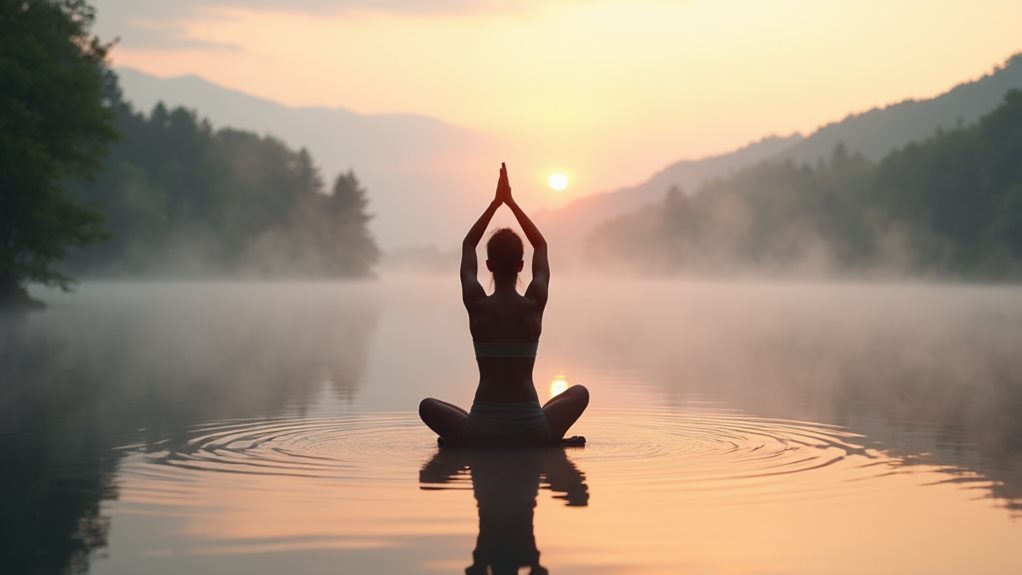
Imagine this: you’re regularly unfolding your mat and devoting time to practice, experiencing a profound shift in your mental landscape. That’s the magic of practicing consistency. When you engage with yoga, meditation, and breathing techniques at least 3-5 times a week, you’ll notice the calming effects kick in. Reduced anxiety? Check. Improved emotional regulation? Yep, that too. It transforms more than just your body—it works wonders on your mind.
Routines aren’t just for the overly organized, you know. They’re your secret weapon:
- Breathing Techniques: Focus on your breath to reduce stress.
- Morning Meditations: Start with 5-10 minutes to set a calming intention.
- Evening Yoga Poses: Unwind for better sleep quality.
- Mindfulness Moments: Embrace more moments of present awareness.
- Quick 15-Minute Flows: Perfect for a busy schedule.
Don’t worry, you won’t need to twist into a human pretzel! Establishing a sequence that adds yoga’s serenity to your life brings peace and calm.
Consistency helps ease stress, offering mental clarity and reducing anxiety. Ready to serve others better? Start your yoga journey—because truly, who couldn’t use a bit more zen in their life?
In Summary
Now that you know which yoga routines calm stormy minds, get on that mat and find your zen! Remember, “Rome wasn’t built in a day,” so don’t stress if you can’t twist into a pretzel yet. Start simple. Focus on your breath. Try a calming pose or two. Consistency is key—practice regularly, and you’ll feel like a new person. Trust me, your mind (and probably your yoga pants) will thank you. So, get moving!


